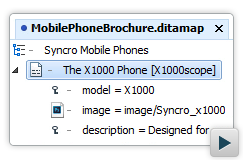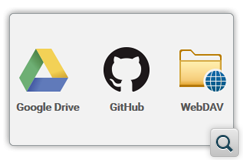Oxygen XML Author 17.1
Oxygen XML
Author version 17.1 includes updates and improvements to make your XML authoring experience
even more productive and effective. The performance of many of the integral components has
been optimized and numerous features were enhanced and fine-tuned to make Oxygen XML
Author even more powerful, dynamic, and easy to use. It also features a spectacular new
visual design that makes everything look crisp and beautiful.
Various DITA-related operations and dialog boxes have been reorganized and improved to
maximize efficiency and convenience. You can also now enable experimental editing and
publishing support for DITA 1.3, including new file templates, scoped keys, and branch
filtering.
Oxygen XML Author extends support for resolving errors and managing the structure of
your documents through powerful actions. Support for XML Quick Fixes was expanded and their
performance improved, while XML Refactoring actions were enhanced to make them more
accessible and powerful.
The Oxygen WebHelp system was also improved to enhance your published output. Google
Search, Google Analytics, and some popular social media widgets can now be integrated into
your WebHelp system and search features are now available in offline mode.
Improved CSS support includes optimized performance and the ability to use several
properties that were previously not supported. Support for some level 4 pseudo-classes was
also added, as well as support for allowing negative values in certain properties.
There are changes in:
User Interface
DITA 1.3 Support
While some DITA 1.3 functionality was available in Oxygen for more than one
year, version 17.1 is a major milestone because we added support for the core DITA 1.3
features (such as key scopes and branch filtering, as well as
many
others). Thus, Oxygen now has the most comprehensive DITA 1.3 support of any
tool on the market.
Create and Edit DITA 1.3 Documents
You can create, edit, and validate DITA 1.3 maps and topics.
Scoped Keys Support
You can establish key scopes and insert references to keys inside or outside
key scopes. Oxygen will also takes key scopes into account when it validates and
checks for completeness, resolves key and content key references, and
publishes.
Branch Filtering Support
The DITA 1.3 branch filtering mechanism makes it possible to reuse the content
of topics multiple times within the same map, each time using different
filters.
DITA Support
Improved User Experience for Reusing Content
While there are multiple ways of reusing content in DITA, Oxygen provides
now a unified interface that allows you to specify what you want to reuse.
Unified Action for Managing Topic References
Multiple actions were combined into a single operation to make them more
efficient. The dialog box for inserting topic references in DITA maps was revamped and
reorganized to include various tabs so that you can configure numerous aspects of the
references in one place.
Improvements to the DITA Map to PDF WYSIWYG Experimental Transformation
Scenario
The experimental DITA Map to PDF WYSIWIG transformation scenario allows you to
transform DITA maps to a PDF file that is very similar to what you see in the
Author visual editing mode. Now the colored highlights set during the
review process are presented in the PDF output.
Publish DITA to Microsoft Office Word Format
If you choose to use the bundled DITA Open Toolkit 2.x distribution, you will
be able to publish your DITA content to Microsoft Word OOXML format using this new
experimental transformation. The support is based on
a plugin contributed
by Jarno Elovirta.
Indicator to Show All the DITA Map References to the Current Topic
When an opened DITA topic is referenced more than once in the map that is
currently opened in the DITA Maps Manager view, an indicator will appear in the top
right-hand corner of the Author mode editor that shows the number of
times the topic is referenced in the map. It includes navigation arrows that allow you to
jump to the next or previous reference. This is especially important for DITA 1.3 where
the point in the map may change the editing context for a topic, for example if different
key scopes are used.
Automatically Contribute New File Templates from a DITA OT plugin
If you
integrate a new DITA-OT plugin in the main DITA Open Toolkit distribution used
by Oxygen and your plugin contains a folder named
template_folders,
all file resources found in the sub-folders will be automatically contributed as new file
templates.
Experimental Lightweight DITA Support
If you choose to use the bundled DITA OT 2.x as the main DITA Open Toolkit
installation, you will be able to create and edit Lightweight DITA topics and
maps.
XML Quick Fixes
XML Refactoring
WebHelp
Google Search and Social Media Widgets Can Be Integrated into WebHelp Output
You can now integrate a Google Custom Search Engine into your WebHelp output.
You can also integrate Google Analytics and some popular social media widgets into your
WebHelp output.
Offline Search
You no longer need to be online to access Oxygen WebHelp search features.
You can now perform searches in your WebHelp system even when you are in offline
mode.
Logical Searches
The Oxygen WebHelp system now supports logical searches that use the
following operators: OR, AND, and NOT. When there are two adjacent search terms without an
operator, OR is used as the default search operator.
CSS
Along with performance improvements the Oxygen CSS rendering engine
supports new properties such as outline and text-indent, new
pseudo-classes such as focus-within and has as well as negative
margins and indents.
Optimized CSS Performance
The performance of CSS stylesheets in Oxygen has been optimized. For
example, you can now move multiple selections in a large table instantaneously. The
performance has also been improved for DITA CSS stylesheets that use pseudo-classes (such
as :hover or :focus), and when opening very large
documents or opening maps in the editor (particularly maps that have topic contents
expanded in-place).
Improvements to the oxy_xpath Function
When computing the styles for an element inside a reference
(XInclude or DITA conref), the CSS
oxy_xpath function will have access to the actual content inside the
references.
Support for the :focus-within CSS Level 4 Pseudo-Class
Added support for the :focus-within CSS level 4 pseudo-class
selector that allows you to style ancestors of elements that contain the current
focus.
Support for the :has CSS Level 4 Pseudo-Class
Added support for the :has CSS level 4 pseudo-class selector
that takes a relative selector as an argument and then evaluates its existence. It can
match an element by taking its child elements into account.
Support for the text-indent CSS Property
Added support for the text-indent CSS property that can be
used to create hanging indents. Oxygen also supports negative values when using this
property.
Support for the 'outline' CSS Property
Added support for the 'outline' CSS property that allows you
to create outlines around visual objects (such as buttons, active form fields, image maps,
etc.) to make them stand out.
Support for Negative Margins and Indents
Added support in CSS that now allows negative margins and indents for block and
inline boxes.
Oxygen WebApp Component
New Administration Page
A new Administration Page has been added to provide a GUI that
allows you to configure the Oxygen WebApp Component. It allows you to easily configure
your license server connection, add/configure plugins, and add frameworks.
GitHub Integration Plugin
The Oxygen SDK includes a plugin that allows you to use the Oxygen
WebApp Component to edit files stored in a public or private GitHub
repository.
Browsing Widget for WebDAV Servers
The Oxygen WebApp Component now includes a browsing widget for WebDAV
servers that can be used for inserting images.
Support for Editing MathML Equations
The Oxygen WebApp Component now supports editing and rendering MathML
equations. You can click on the equation to open an editing dialog box and you can also
edit the XML source of the equation.
Support for Rendering SVG Images in the WebApp
The Oxygen WebApp Component now supports rendering embedded or referenced
SVG images in XML content.
WebApp Component API
Dynamically Enable/Disable Actions on the Toolbar
The
refreshActionsStatus(ids) method has been added that allows
you to dynamically enable or disable action on the toolbar in the Oxygen WebApp
Component.
API
A detailed list of all changes to the Java API can be found
here.
Add a Drag and Drop Listener to Author Mode
The WSAuthorEditorPageBase.addDNDListener(...) API method
allow you to add a drag and drop listener in Author mode from a
plugin.
API to Customize Callouts
AuthorStylesheet Plugin Extension Type
The AuthorStylesheet plugin extension type allows you to
contribute stylesheets (CSS or LESS) as extra layers for rendering elements in
Author mode.
Change the Tag Display Mode
The WSAuthorEditorPageBase.getTagsDisplayMode() and
WSAuthorEditorPageBase.setTagsDisplayMode(int) APIs were added that
allow you to get or change the display mode for tags in Author
mode.
Customize Actions in the Review Panel
Customize Highlights in Author Mode
Execute XQuery Update Scripts on Content in Author Mode
Refresh References for a DITA Map
Retrieve Clipboard Content Copied in Author Mode
Treat Expanded or Referenced Content as Transparent when Running XPath
Expressions
A new API method
AuthorDocumentController.evaluateXPath() has specific
parameters that can specify if the entities and
xi:include elements are
replaced with the actual content that is referenced when the XPath is
executed.
Security
Other
Support for Executing XQuery Update Scripts Directly Over Content in Author
Mode
A new default Author mode operation
(XQueryUpdateOperation) has been added that allows you to execute an
XQuery Update script directly over content in Author mode.
Component Updates
Oxygen updates many of its third party components: Calabash 1.1.5, DITA OT
2.1.2, EpubCheck 4.0, LESS 1.7.5, Saxon 9.6.0.7, TEI Schema 2.8.0, TEI XSL
7.39.


